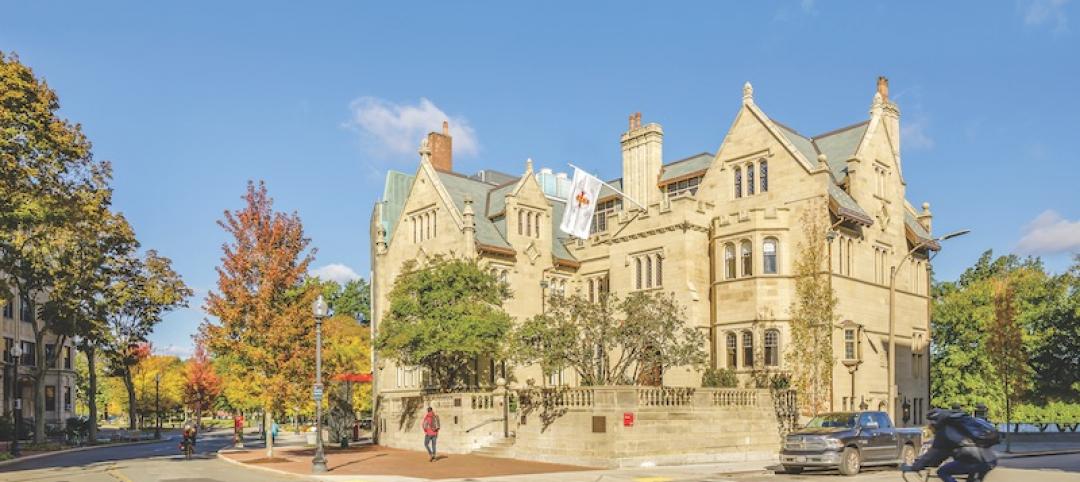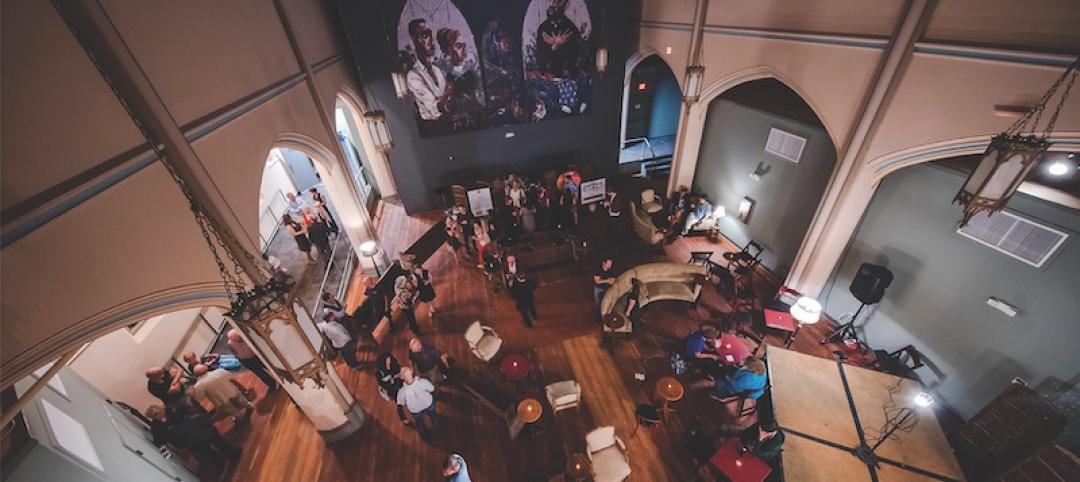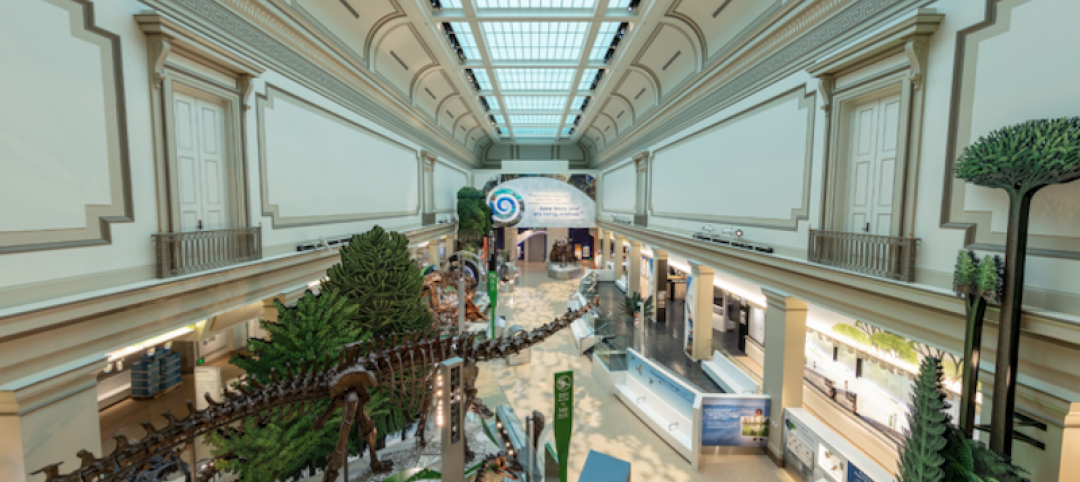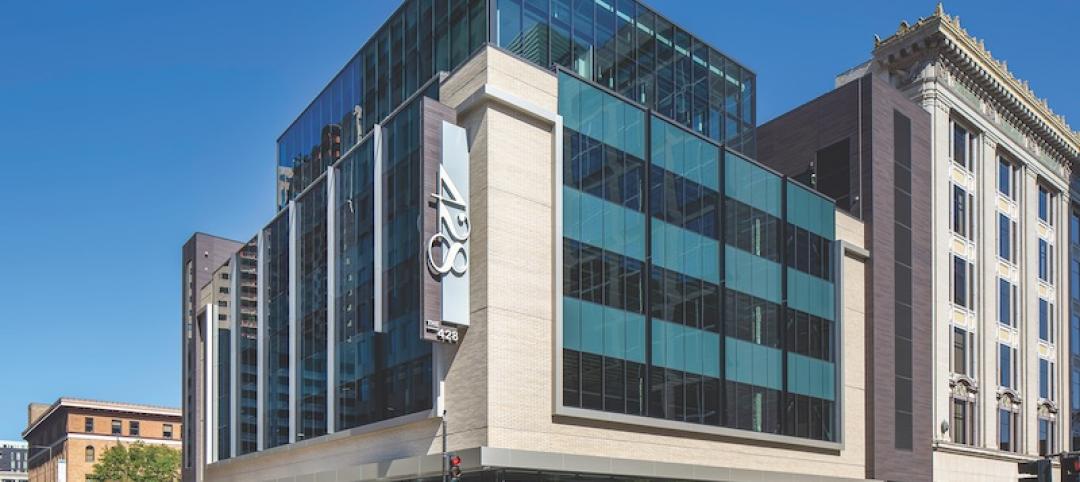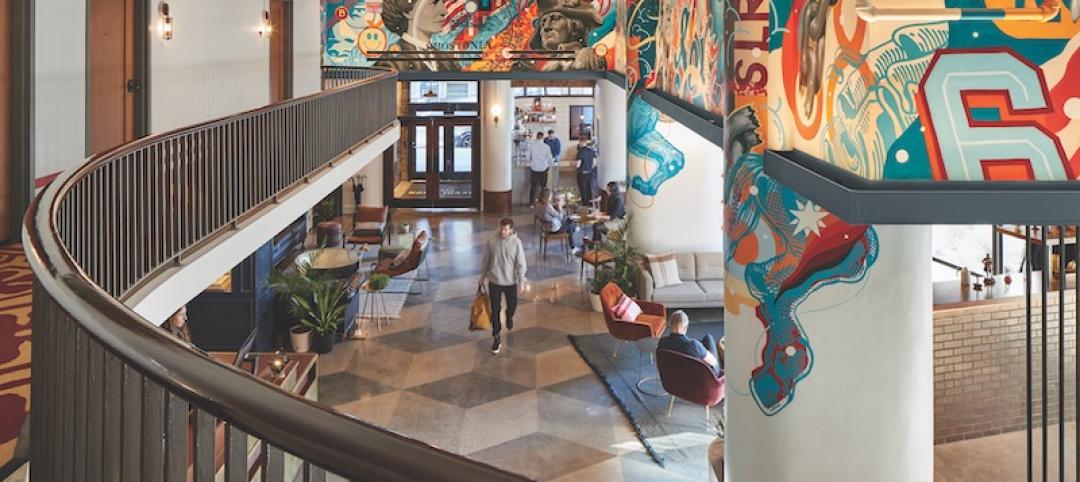The historic Enid A. Haupt Conservatory is a Victorian-era glasshouse that protects an acre of the New York Botanical Garden’s living plant collection, located on 350 acres in The Bronx, N.Y. The Conservatory has been synonymous with the Garden since it opened in 1902. The Conservatory has been listed on the National Register of Historic Places since 1967, and was designated a New York City Landmark in 1973.
The Conservatory’s signature architectural feature is its Palm Dome, approximately 90 ft high and 100 ft in diameter, with 22 curved steel meridians spaced equally around its circumference. Supporting and stabilizing the dome’s load is a compression ring constructed of a 36-inch-deep curved steel plate with single angles riveted to its top and bottom.
During regular maintenance of the compression ring in 2013, signs of deterioration were noted. The structural system lacked redundancies, so the ring itself needed to be accessed directly for repair. But the extent of what repairs couldn’t be gleaned until the dome’s wood cladding was removed.
Based on its corrosion durability analysis, the structural engineer Silman recommended that repairs be performed within five years to prevent further deterioration. The jobsite, though, would be tricky, filled with massive plantings within the Conservatory that couldn’t be disrupted. In addition, the space’s geometry, as well as concealed finishes at the compression ring, complicated the dome restoration’s execution.
The restoration of the Palm Dome that included the repair of the compression ring received a Gold award from BD+C’s 2020 Reconstruction Awards program.
DESIGN HAD TO DEAL WITH COMPONENT INACCESSIBILITY
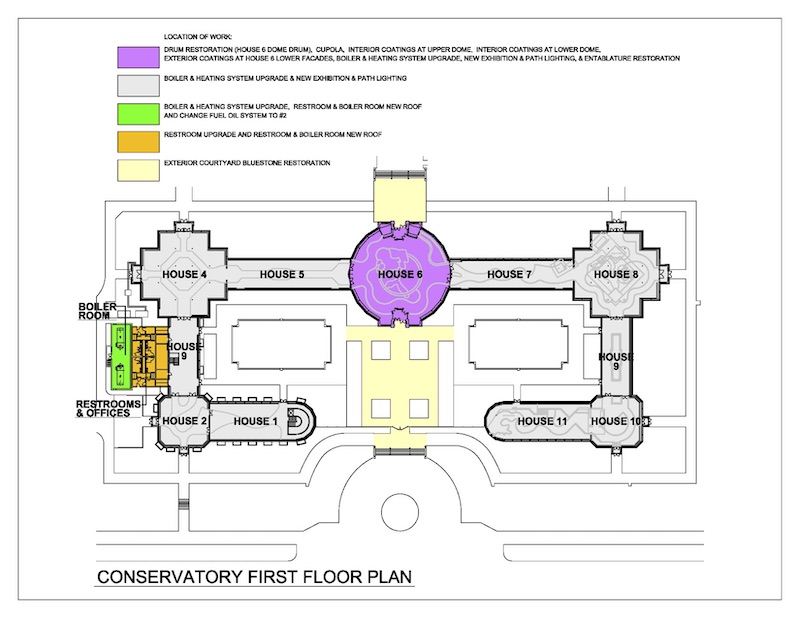
Aside from the restoration of the Palm Dome, the Conservatory's heating system and restrooms were upgraded. Image: NYBG.
An exterior survey conducted in 2013 used a traditional aerial platform lift with enough reach to access to cupola. The more recent, extensive investigation was completed by a company called Vertical Access, from the building’s existing catwalk at the upper compression ring, and from industry rope access.
The project’s investigatory phase proved to be challenging, primarily because most of the compression ring was inaccessible during the design phase. The project’s reconstruction also had to be sequenced to allow for observations of existing conditions and updates to specified repairs based on in-situ conditions.
The design work for the repair and restoration was undertaken in 2018, and the primary renovation performed in 2019-20 when the Conservatory was closed for one season.
SCAFFOLDING WAS THE PROJECT’S BACKBONE
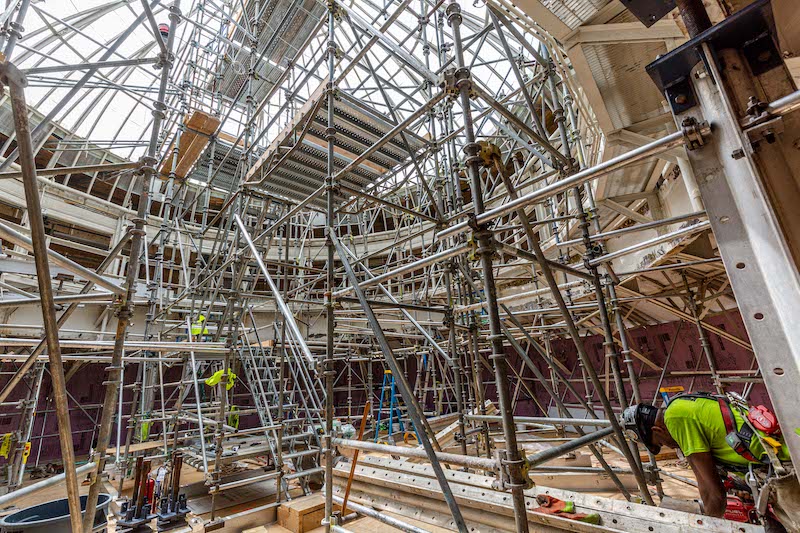
A scaffolding system was the spine of the project. It served as a thermal barrier, a working platform, and a structural support for the Dome’s compression ring. The Building Team selected a traditional scaffolding with a dance floor. Credit: Marlon Co., New York Botanical Garden
Scaffolding turned out to be this project’s most valuable tool. During construction, the scaffolding system was the project’s backbone, as it served as a thermal barrier to protect the plant and tree life below it, a working platform for the project’s building trades, and a structural support while the compression ring was being repaired.
The Building Team, working with the Garden’s horticultural team, chose a traditional standing scaffold with a dance floor. The positioning of the scaffolding’s legs had to account for the conservatory’s plantings as well as a reflecting pool and buried utilities.
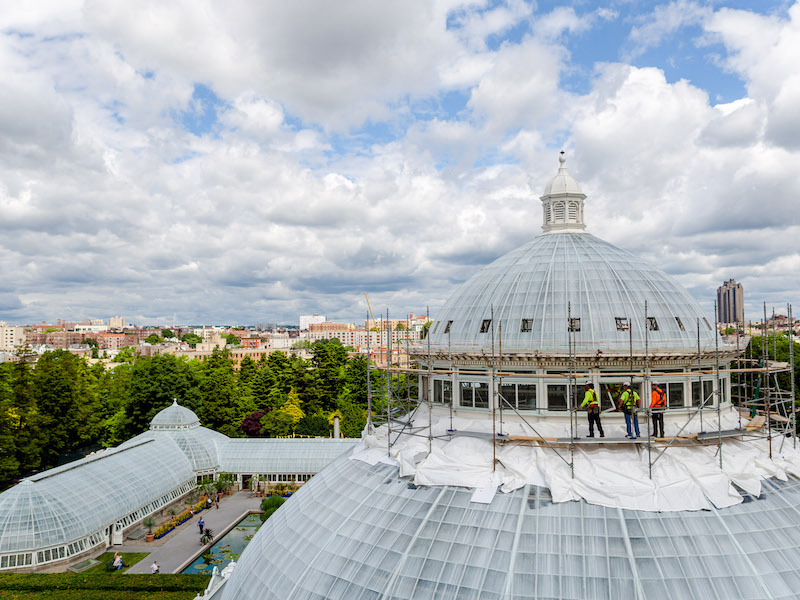
Workers install the exterior scaffolding walls and roof to create a weatherproof barrier so the facade of the dome drum could be removed during restoration (above). Workers install the last row of glass below the dome drum during the restoration (below). (Photo credit: Marlon Co., NYBG)
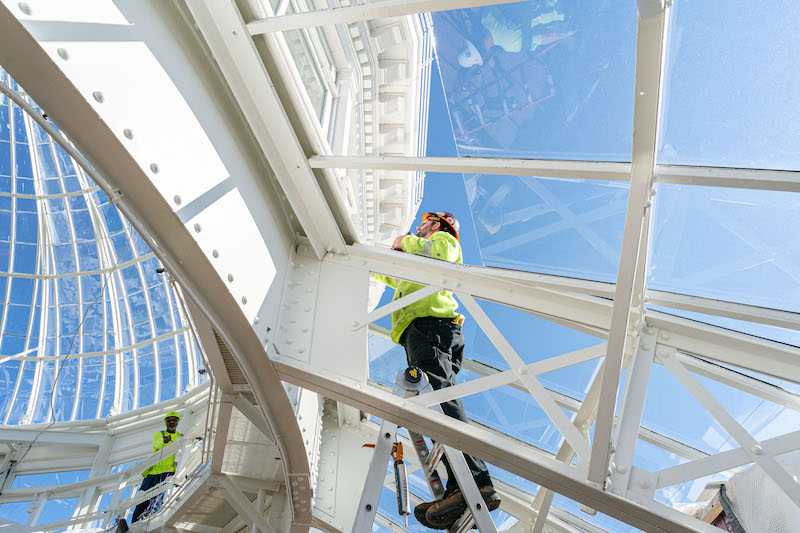
The Dome drum’s operable windows had already been replaced during a restoration in the 1990s. The remaining elements of the façade were replaced with aluminum during the 2019-20 restoration of the Palm Dome. To remove the façade of the dome drum for restoration, workers installed exterior scaffolding walls and roof to create a weatherproof barrier for the Palm Dome.
Aluminum profiles were fabricated and tested to match the original dome drum façade. The replacement of the original façade at the dome drum required constant coordination among the trades. The scaffolding provided multiple work surfaces at various levels of access to the facade.

Fabricated aluminum profiles were matched with the original dome drum. Photo credit: Rough Brothers Inc., 2019-20
Once scaffolding was erected, the Building Team could remove wood cladding to expose the conservatory’s steel support, which in some sections showed considerable rust corrosion. In the worst-case locations, several angles at the top of the compression ring required full replacement. Where there was less-severe deterioration of the compression ring, the Building Team welded a supplemental plate to the top of the existing angle for repair purposes.
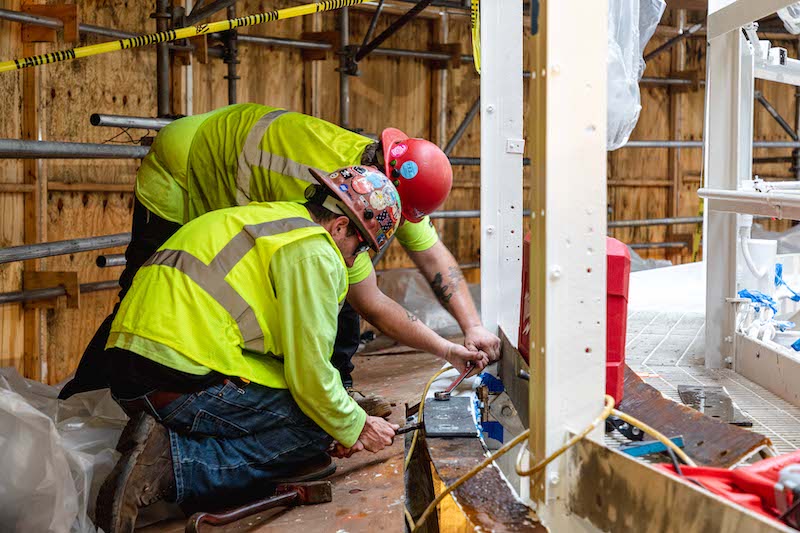
Removing wood cladding revealed severely corroded steel supports of the cornice (top image, credit: Herbert Chang, Silman). The Building Team determined that the top and bottom angles legs with significant section loss would be repaired locally, and that the vertical plate section of the compression ring would remain intact during repairs (middle photo, credit: Herbert Chang, Silman). Metal workers installed a metalized steel plate on the top angle of the compression ring (bottom image, credit: Marlon Co., NYBG).
The team installed temporary replacement angles and splice plates while permanent angles were shop-fabricated. Fabrication allowed for exact dimensional matching and prevented gaps between the respective angles and the compression ring plate.
To limit the amount of shoring needed during the repair process, the Building Team decided that the top or bottom angle legs with significant sections were locally replaced while the vertical plate of the compression ring would remain intact throughout the repair process. (Plan B was the project’s shoring engineer.)
AN EXHIBITION SHOWCASES THE RESTORATION
The existing coating of the compression ring’s vertical plate and the upper and lower angles was removed to expose bare steel. The center 18 inches, whose steel manifested little or no erosion, were left intact. H2M Architects, a coating specialist, was brought in to review the process, as well as to select which high-performance coating would be applied. In preparation for that application, workers power-washed the dome.
The Conservatory is now sprayed with a lime-based shading compound each spring to mitigate excessive temperatures inside during summer months.

The restored Palm Dome is now sprayed annually with a shading compound to mitigate heat inside the Conservatory. Credit: Marlon Co., NYBG
Along with the dome restoration, the conservatory's boiler and heating system and restrooms were upgraded.
In January 2020, the New York Botanical Garden mounted an exhibition about the restoration, called “From Cornice to Cupola: the architecture of the Enid A. Haupt Conservatory.” The exhibition also explored the history of glasshouses.
PROJECT INFORMATION: Size 55,000 sf (Conservatory), 7,900 sf (Dome footprint) Construction start and finish April 2019 to May 2020 Cost $18 million Delivery method Design-bid-build
BUILDING TEAM: Submitting firm and owner/developer New York Botanical Garden Architect Jan Hird Pokorny Associates SE Silman MEP JMV Consulting Engineers GC EW Howell
Related Stories
Reconstruction Awards | Dec 13, 2019
A manse makeover: The Dahod Family Alumni Center at the Castle
A 1915 castle on BU’s campus is carefully restored for alumni events.
Reconstruction Awards | Dec 13, 2019
Community effort: Rose Collaborative
This post-Katrina project has become a citadel of the arts and education in the Crescent City.
Reconstruction Awards | Dec 12, 2019
New flight pattern: Google, Spruce Goose
The hangar that once housed the Spruce Goose is adapted to meet a tech giant’s workplace needs.
Reconstruction Awards | Dec 10, 2019
Enter the world of deep time: David H. Koch Hall of Fossils
The new enclosed FossiLab gives visitors a glimpse into the exacting work of Smithsonian scientists and preservationists.
Reconstruction Awards | Dec 6, 2019
TWA Hotel at JFK International Airport: Home away from home
A dormant, 1960s-era flight center is converted into a snazzy hotel and conference facility.
Reconstruction Awards | Dec 6, 2019
Columbus Metro Library Hilliard Branch
Senior living clubhouse becomes a modern library in central Ohio.
Reconstruction Awards | Dec 5, 2019
The 428: St. Paul's office corner
A long-forgotten five-and-dime store becomes a speculative office property in Minnesota’s capital.
Reconstruction Awards | Dec 4, 2019
The squeeze is on: The Revolution Hotel
Once a 1950s-era YWCA, The Revolution is now a hip new hotel in The Hub.
Reconstruction Awards | Dec 2, 2019
Hudson Commons: Over the top
A project team converts a 1960s industrial structure into a Class A office gem.
Reconstruction Awards | Nov 26, 2019
Sweetest sounds: Metropolitan Opera House
An early 20th-century opera house now hosts concerts from Disney Acapella to Weezer.


